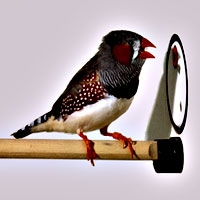Songbird passes grammar test using mnemonics
Songbirds apparently use mnemonics rather than more complex grammatical rules to recognise structures in which they have been trained. Leiden behavioural biologist Caroline van Heijningen published an article on this subject on Tuesday 17 November in PNAS.
Recursive structure

This discovery conflicts with research carried out a few years ago. At the time it was important news. The researchers claimed that another species, the starling, like humans is able to use more complex grammatical rules. The research conducted by Van Heijningen and her colleagues shows that this claim is premature. Like earlier researchers, Van Heijningen concentrated on the ability to recognise 'recursive' language structures. In a recursive structure, one sentence is embedded within another having the same structure. For example, in 'the zebra finches, that the researcher tested, sang,' the sentence 'the researcher tested' is embedded in the sentence 'the zebra finches sang.'
Droste effect

This embedding - a kind of Droste effect - was thought to be a unique human ability of language according to a controversial but popular scientific assumption. In recent years, a number of different species - including the marmoset and the starling - have been tested for their ability to recognise the Droste structure. Starlings proved to be able to distinguish this structure using the recursion rule in reconstructed starling song. This should demonstrate that this phenomenon is not unique for humans. However, one crucial test was missing, namely whether starlings recognise this structure in other sounds than those with which they are trained.
Zebra finch
Van Heijningen carried out this test on a different species of songbird, the zebra finch. Like starlings, zebra finches, if they are trained, are able to make a distinction betwen recursive and non-recursive artificial song. But when they were then tested with unknown song sounds with the same structures, seven of the eight birds were no longer able to make the distinction. One zebra finch was able to do this.
Abstract rules
Further research brought to light that the zebra finches applied more simple rules to resolve the task than the recursion rule, including the finch that in the first instance seemed to have learned the recursion rule. Very clever, you might say: why make something difficult if you can make it easy? Although songbirds are able to use simple, but relatively abstract rules, the conclusion is still that there is no convincing evidence that other species than humans are able to recognise complex grammatical rules.
Unique human characteristic
Research on humans has now shown that the Droste effect in lanquage is probably less important than was originally thought: humans themselves also tend to use more simple rules in this kind of task. There are also doubts about how and in what form the Droste effect occurs in natural human languages. In summary, the claim that other species could also recognise these complex grammatical rules is premature.
Sound fragments:
Two ‘sentences’ with the ABAB pattern (wav) and I'Embedded sentence’ according to the AABB pattern (wav).
Article: Simple rules can explain discrimination of putative recursive syntactic structures by songbirds: A case study on zebra finches Caroline A. A. van Heijningen, Jos de Visser, Willem Zuidema, and Carel ten Cate, Proceedings of the National Academy of Sciences USA
